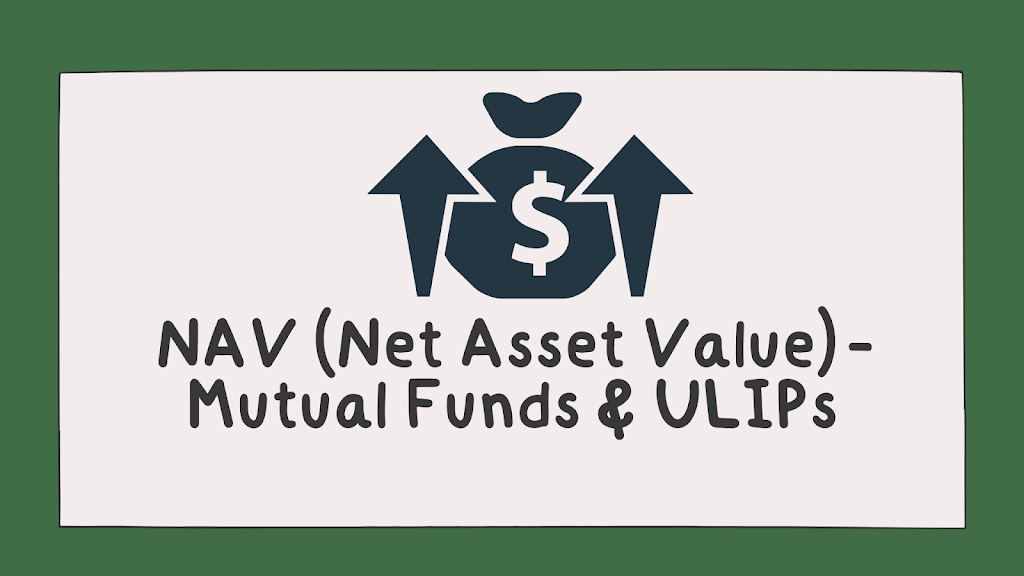
We are going to talk about net asset value When you invest in Mutual Funds or unit-linked Insurance plans, ULIP Or you have an equity-linked saving scheme (ESS), So in that, you are quoted with NAV. NAV Means Net Asset Value What is NAV? People get very confused about this. People don’t understand what exactly NAV means And how will we know that our money has grown So in this video,
 |
| NAV (Net Asset Value) – Mutual Funds & ULIPs |
we will discuss the complete concept of NAV in detail. You must read this blog till the end Let’s go straight to the blackboard, If we talk about the definition of Net Asset Value So this value is per unit of a Mutual fund or ULIP So as an investor whenever you buy or sell a mutual fund, So you buy or sell at NAV price In one way, let’s assume that, the price of the share if you invest directly in the share So you invest based on share price, And in Mutual Funds and ULIPs, you invest at the price of NAV or sell at the same price Let us understand this as an example Let’s say it’s a fund and its total asset value is Rs 50 crores. And this fund will invest Rs 50 crores somewhere And whatever returns it gets from it, it will return to you as an investor. So its fund owners can either find 10 investors Who can invest 5-5 crores So they have to release only 10 units But this does not happen in real-life scenarios. Because mutual funds now have to attract retail investors They break this fund into multiple units Let’s say they launch two crore units or shares So this 50 crore amount gets divided into two crore units or shares. And you can buy multiple units or shares So if I give you an example here, let’s say You want to invest 25,000 Rs in any XYZ mutual fund And let’s say 25 Rs is net asset value(NAV) The value of one unit is ₹25 So you can buy a thousand units of that simply it means. so you will get a thousand units of ₹25 This is ₹25, this is your Net Asset Value So if we want to calculate it in the formula then how is it calculated in the formula Net asset value= asset – liabilities This means the fund will invest this ₹ 50 Crore separately In stocks, Or in the bonds Or it may keep some money in the form of cash. Then what will be its liabilities There will be some administrative expenses to manage this fund There must be office expenses, management fees That has become your liability. So assets minus liabilities divided by the total number of units (assets – liabilities / 2 ) The total number of units is 2 crore then you will get net asset value So assets = Stocks+bonds+cash Or else he invests the fund somewhere then you will add that So for example, we take the example of Equity Mutual Fund which invests only in stocks. Let’s say It invests only in two stocks. Let’s say in TCS this Mutual Fund invested ₹ 25 crore And let’s say they also bought HDFC’s share And they have invested ₹20 crores in HDFC So ₹45 crores will be adjusted here. And they kept five crore cash with themselves So how many of the total assets do you have ? You have ₹ 50 crores. Now how much will be the liabilities of this mutual fund? One is your management fee, And you have some claims too There have been some redemption claims in the case of mutual funds. Somebody said that he has to withdraw his money. So those claims have to be fulfilled In the case of ULIP there are Insurance claims also So it becomes a kind of liability of the fund. But in this case, we consider only the management fee as a liability. Suppose its liability or management fees are 2% per annum. So now you have to calculate per day, You will divide it by 365 These will be your per days fees If we have to calculate it for 50 crores then Then 0.02 divided by 365 Multiplied by 50 Crore Its value came around 27,400 Rs Let’s quickly calculate NAV in this case You will keep assets of ₹50 crores here So here I write 50 Crore From this, we will subtract liabilities So this is our liabilities, management fees 27,400 will be deducted from it Now see the fee of one day ₹27400 is very less in front of ₹50 crores Doesn’t matter much, now we will divide it by the total number of units. The total number of units is 2 crores, So if we put two crores here, So our NAV will come out to be ₹ 24.99 I take it as ₹25 approximately. ₹27,4000 value is very negligible in front of ₹50 crores So we could have directly divided 50 crores by 2 crores. So the value of NAV comes to be ₹25. So suppose if you invest ₹25,000. Then you will be allotted a thousand units. So in this way, you can calculate Net Asset Value Now let us see how our returns will be calculated Let’s say after 1 year the value of your assets The value of TCS stocks goes from 25 crores to 35 crores, The market is doing very well. The value of TCS stock has become ₹35 crore And let’s say the stock of HDFC goes from ₹20 crores to ₹25 crores. And you still have maintained the cash amount as it is. So here the value is ₹5 crore This is the value of HDFC And this is your cash component, right! Here I am giving you the example of only 2 stocks. It can also be multiple stocks. If you have invested in Hybrid Mutual Funds, then it can be Bonds too. So this is the value of assets Units will remain the same. And I assume the liabilities are negligible The fees of management are relatively very less it is only 2% And we have assumed the remaining liabilities are zero. So now how do we calculate Net Asset Value You will add all of these. So it will be 65 crores Dividend by 2 crores, so here your net asset value is ₹32.5 crore after 1 year So basically what are your returns You ₹ 25,000, your units will remain the same Then 32.5 × 1000 units So your amount ₹25000 1 year ago. That now became ₹32,500. So if you withdraw the amount after 1 year then you will get ₹32,500. So in this way you got 30% returns. Your money increased by 30%. So this is your return on investment So if I say in short then in a way NAV is the share price As you invest in shares, you see the price of the share Similarly, if you invest in Mutual Funds or ULIPs, you will see the value of the NAV. And whenever you buy or sell mutual funds or ULIPs If on any day you buy or sell before 3:00 PM So the NAV of the same day is considered And if you buy or sell after 3:00 PM then NAV of the next day is considered So take care of this thing too So I hope you must have cleared the concept of NAV very well.



